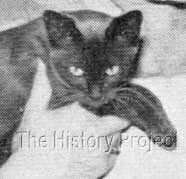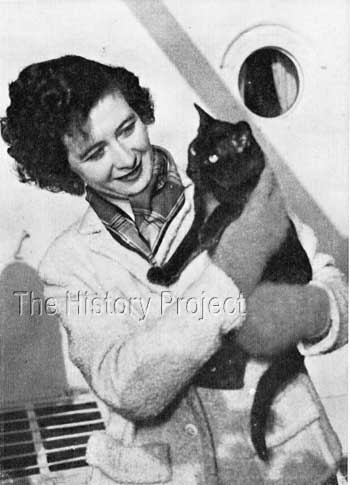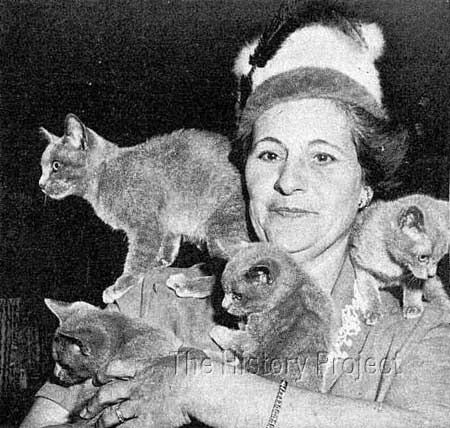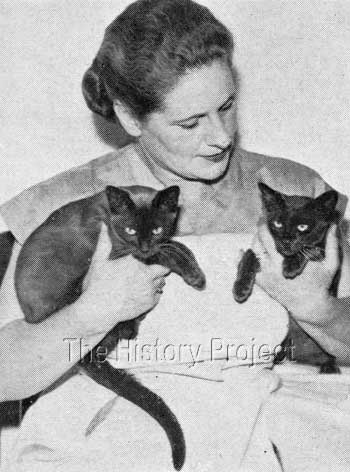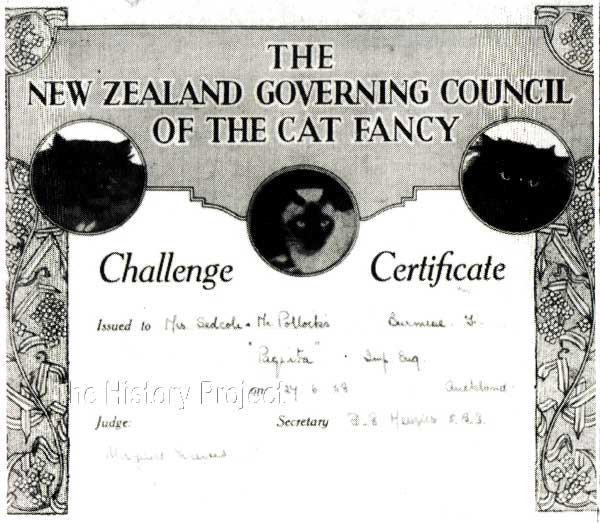 | ||||||||||||||||||||||||||









|
PAQUITA (1956)PHOTOS | SOCIAL MEDIA | REFERENCES
HISTORICAL BACKGROUND:The story of 'Paquita' and her subsequent progeny, is very much about the interplay of the original American bloodlines behind her sire and grandsire, 'Casa Gatos Da Foong' and 'Casa Gatos Darkee' respectively and what each of these males brought into the gene pool with them. When Mrs. Lilian France of Derby imported the first American-bred Burmese into her 'Chinki' cattery in the United Kingdom in 1949, she opened a veritable flood-gate; one that would largely influence the spread of foundation American Burmese bloodlines around the globe. Her first imports were two females and a male, respectively named 'Chindwins Minou Twn', 'USA Ch. Laos Cheli Wat' and 'Casa Gatos Da Foong'.2 In 1953, Mrs France, assisted by the late Lord Aberconway, imported another male, 'Casa Gatos Darkee'.2 It was from various combinations of the lines of these two 'Casa Gatos' males and their sons and daughters, that enough breeding stock was eventually established in the United Kingdom to allow Burmese kittens of sufficient quality to be available for export to breeders located elsewhere around the globe. When Mrs. France made a decision to move the Channel Islands in early 1954, all her Burmese stock were taken over by Mr. and Mrs. V. Watson in March of that year.2 'Paquita', a sable female, was sired by the original American imported male 'Casa Gatos Da Foong', and through her dam, was a grand-daughter of 'Casa Gatos Darkee'. She was one of three sable Burmese imported into New Zealand in early 1957, by Mrs. Beryl Sedcole and her son, Mr. Hayden Pollock, of Auckland. The three were a male, 'Merrick Apollo', and two females, including 'Nilgiris Buru Kaihau' and the lovely little 'Paquita', who was a favourite with Mrs. Sedcole.1 These three cats were later supplemented by the addition of another sable Burmese male, 'Merrick Viking', imported by Mrs. Sedcole and Mr. Pollock in 1958. 'Viking' brought with him, a much needed partial outcross, being sired by 'Darshan Khudiram', another American-bred sable Burmese, imported into the United Kingdom by Mrs. Watson. From these four cats, the Burmese breed gained its initial foot-hold in New Zealand, with the 'Ransein' cattery actively promoting the breed and sharing the lines within New Zealand and with breeders across the Tasman, in Australia.1 PARENTAGE & OWNERSHIP:
CH Laos Teddi Wat of Yana, sable
Casa Gatos Da Foong, sable
| Yana Jo Anna of Casa Gatos, sable
Paquita, Jun-11-1956, sable Burmese, F
| CH Casa Gatos Darkee, sable
Kyneton Aka, sable
Chinki Amber, sable
'Paquita' was born on 11th June 1956, sired by Mr. and Mrs. Watson's 'Casa Gatos Da Foong' and out of Mrs. Dunn's queen, 'Kyneton Aka'. Her dam, was sired by 'Casa Gatos Darkee', and her maternal Grand-dam was 'Chinki Amber', also by 'Casa Gatos Da Foong'. So 'Paquita' was in fact the product of a grandsire to grand-daughter breeding (based on a line-breed of her sire 'Da Foong') and as her Grand-dam was out of USA Ch. Laos Cheli Wat, she was in fact from all American lines, but born in England.
This line-breed on 'Da Foong', then out to 'Darkee' (considered to be a reasonable outcross) and back to 'Da Foong' gave 'Paquita' a fixed genetic make-up that was predominated by her sire 'Casa Gatos Da Foong'. 'Paquita', along with 'Nilgiris Buru Kaihau' and 'Merrick Viking' was registered in the joint ownership of Sedcole and Pollock, on 1st May 1957.2 Mrs. Sedcole was already a successful breeder of Persians under her own 'Ellrose' prefix, with an established reputation. She and her son Hayden met Miss Kathleen Yorke when the latter visited New Zealand to judge at Auckland Cat Club's show in June 1956. Miss Yorke was impressed with the standard of the cats she had handled and assessed and had apparently voiced her opinion that she would like to see the Burmese breed established in New Zealand. Her description of the Burmese impressed the young Mr. Pollock, who apparently decided he would like to breed them and subsequently worked to convince Mrs. Sedcole to support his proposal. Mrs. Sedcole, being worldly-wise knew that most of the work in feeding and looking after the cats would fall on her shoulders, so she proposed that they go into a partnership in order to breed Burmese.1 According to Grace Burgess: "They wanted a prefix indicative of the breed and so chose 'Ransein' - the 'Ran' for 'Rangoon' and the 'sein' from 'Bashien' - two large cities in Burma."2 The cats, she advises, were brought through an agent in England, who chose the cats and made all the arrangements surrounding travel and travelling boxes.2
SIBLINGS & SHOWS:As a daughter of 'Casa Gatos Da Foong', 'Paquita' has a great many sire siblings. Most numerous among these are in the main, those bred by Mrs. France under her 'Chinki' prefix3, out of her two American imported queens 'Laos Cheli Wat' and 'Chindwin's Minou Twn'. There were equally numerous cats by 'Da Foong' also bred by his secondary owners, Mr. and Mrs. Watson, under their 'Sealcoat' prefix.4 But also from other well-known breeders who bred more than a handful of kittens from 'Da Foong', which included the likes of Mrs. M.Smith of the 'Sablesilk' cattery3 and Dr. and Mrs. Groom, of the 'Nilgiris' cattery.3 The most significant sire sibling of note in this case was 'Nilgiris Buru Kaihau', born, 26th April, 1956, bred by Dr. and Mrs. Groom, as it was she who was exported to New Zealand along with her more than three-quarter sister 'Paquita' and the male 'Merrick Apollo' who was a son of 'Casa Gatos Darkee' and grandson of 'Da Foong'.
A litter brother to 'Paquita', named 'Tomahawk', was originally retained by Miss Dunn, but later sold to a syndicate in Australia. Grace Burgess gives us further insight into this sire-sibling of 'Buru Kaihau':
"Miss Dunn had already sent one of the first Burmese (Paquita) to New Zealand but had kept her litter-brother Tomahawk for the English show season. At this time it was not compulsory in the United Kingdom to use a prefix and I understand Miss Dunn preferred to keep the use of her prefix for the progeny of cats of her own breeding. This season had proved very successful for Tomahawk as he was only one point behind the winner of a points cup awarded for the most successful Burmese kitten of the year."2 Eventually however Miss Dunn let it be known to her contacts in Australia that 'Tomahawk' was available for purchase. A syndicate of four breeders was formed and in due course, 'Tomahawk' arrived in Sydney in August 1957, aged 14 months.2
Shows: Not long after their arrival in New Zealand, 'Apollo', 'Paquita' and 'Buru Kaihau' were finally benched at a Show organised by the Auckland Cat Club and the Auckland branch of the Official Siamese Cat Club. This took place in the Concert Chamber of the Auckland Town Hall on 2nd March, 1957, with all three cats being placed on 'Exhibition Only'.2 Subsequent to this initial public exposure, 'Nilgiris Buru Kaihou' became the first Burmese cat to be shown competitively in New Zealand, successfully gaining her Championship title on 7th June, 1958 - a hallmark date for Burmese in New Zealand! 'Merrick Apollo' and 'Paquita' followed suit, gaining their respective Championships on the same day, 12th July, 1958.1 At the Hamilton Cat Club show of 1957, Judge Mrs. Bernice (Bunny) Downey, had placed 'Buru Kaihau' ahead of 'Paquita' in the class. This somewhat surprised Mrs. Sedcole, who had been told by the English agent that she expected 'Paquita' to do better at shows and that 'Buru Kaihau would be a useful brood queen.2 It therefore appears possible that the decision of Mrs. Downey to award a first to 'Buru Kaihau' and a second to 'Paquita', may have played some part in the fact that it was 'Buru Kaihau' who first gained her Championship. BREEDING & PROGENY:'Paquita' appears from all accounts to have been an exemplary brood queen from the beginning. Grace Burgess elaborates further: "Strangely enough, Paquita had seven kittens in her first litter and Nilgiris Buru Kaihau had only one kitten - born dead. However, both queens proved to be prolific breeders and Paquita had seven or eight litters of seven kittens each time, and normally her litters were of five or six kittens."2 Confirming the progeny of 'Paquita' presented the writer with some difficulty, as Volume Three of the NZ Governing Council of the Cat Fancy's Stud-book, appears not to have been published. This would have covered the period between the end of Volume 2, (31st December, 1954) and the start of Volume Four, in the late 1950s. Fortunately copies of the pedigrees of Mrs. Sedcoles imports are preserved, and details of their New Zealand registration, can be found in Grace Burgess's invaluable book, 'Burmese Cats' published in 1970. Grace also provides a list of the names of 'Ransein' cats exhibited at major New Zealand shows between 1958 and 1963. But although we find the names of the cats in this publication, it does not identify the parentage of each exhibit. So this information has had to be gathered from a combining research of old pedigrees and examining early Australian studbooks. Although there were clearly a good number of progeny from 'Paquita' that were both retained and sold for breeding, her main claim to fame is as the dam of 'RANSEIN TALISMAN'. This was a Sable Burmese female for whom we have a pedigree but no date of birth, but who was sired by Ch. Merrick Apollo (Imp.UK) and out of 'Paquita' (Imp.UK). Records show that 'Ransein Talisman' was shown at Auckland Cat Club's 11th Championship Cat Show in 1960, and among the other Ransein cats exhibited at this show were 'Ransein Silmarein', 'Ransein Venus' and 'Ransein Trinity'. We do know that 'Silmarein' was out of 'Nilgiris Buru Kaihau', but we do not know for sure at this point who the dam of 'Venus' or 'Trinity' was, so they could have been out of 'Paquita', given that Paquita was the first to breed successfully. 'Talisman' is known to have produced a litter in April, 1960, so she must have been born no later than 1959 and possibly as early as 1958, possibly in the first litter from 'Paquita'. 'Talisman' was herself, a significant historic stepping stone, being the first sable Burmese in New Zealand to produce a Blue Burmese. The story of her naming and the subsequent famous litter she produced when bred to 'Ch. Merrick Viking' is ably recorded by Grace Burgess: "Mrs. Sedcole told me that one of her Burmese kittens which, for no particular reason was named 'Talisman'. One dictionary I referred to gives the definition of 'talisman' as: 'something producing wonderful effects…' Mrs. Sedcole's dictionary said '…the source of something strange and wonderful'. "Ransein Talisman was most aptly named because, mated to Merrick Viking, in 1960 she made history when she produced the first All-blue litter born in the southern hemisphere. These kittens were born on 12th April, 1960, and registered with the NZGCCF on 28th June, 1960. "Mrs. Sedcole very amusingly related the story of this litter. As the days went by she was very worried as the kittens didn't start to darken up in the usual way. To her they appeared to be a sort of lavender. One day she mentioned this to a neighbour and suggested she come and look at them. As soon as the neighbour saw them she exclaimed: 'They're blue - they are just the colour of your Blue Persians'. Mrs. Sedcole then remembered that a Blue kitten had been born in England, so she wrote to Mr. Watson and told him of the her four Blue Burmese kittens. He replied congratulating her on two things - firstly that she had had a litter in which all the kittens were Blue instead of only one or two; secondly, on the fact that the litter was a mixed one of both sexes - 2 female and 2 male."2
In fact, breeders in England had been considering where the dilution factor for blue had been inherited from, and in the case of those born in England, it was determined that the carrier of the dilution was 'Casa Gatos Darkee'. He of course, was the sire of the first Burmese male imported into New Zealand which was 'Ch. Merrick Apollo', but the father of this litter was 'Ch. Merrick Viking'. However, although 'Viking' was sired by 'Ch. Darsham Khudiram', his dam was 'Merrick Ana', a full sister to 'Apollo'. Hence 'Viking' probably inherited his genes for the dilution from his dam (who was by 'Casa Gatos Darkee'). In addition, both of the females imported by the partnership of Sedcole and Pollock, 'Paquita' and 'Nilgiris Buru Kaihau' were also grand-daughters of 'Darkee' and so it now seemed likely that 'Paquita' had inherited this dilution and passed it on through her daughter, 'Talisman'. As it happens, 'Merrick Apollo' was also eventually proven to carry the blue dilution, inherited from his sire 'Darkee'. This happened when one of the first blue kittens, from 'Talisman', registered as 'Ransein Blue Amelia' was bred to him and in turn produced a second generation Blue, in 'Ch. Ransein Mai Ling'. American breeders still were deciding whether the dilution was inherited from the original import out of Burma, 'Wong Mau'; or whether it was brought into the gene pool via the first and original outcross to the pointed (Siamese) male, 'Tai Mau'(Imp.) (ACA 12389).10
Grace Burgess continues: "This all-Blue litter was, naturally, of great interest throughout the Cat Fancy world and the most astonishing thing about it was that both sire and dam were brown, with no blue in their pedigree as far as it has been possible to ascertain. As a result of this litter, which proved that it was possible to breed Blue Burmese from Brown Burmese, Mrs. Sedcole told me that the Governing Council of the Cat Fancy in England decided that Blue Burmese were entitled to their own breed number and Blue Burmese were allotted Breed No. 27A in July, 1960. "The two female kittens from this all-Blue litter litter were absolutely identical so that even Mrs. Sedcole couldn't tell them apart. The two male kittens were as different from one another as it is possible to be." The author then gives us the names of the males, which were 'Ransein Blue Andrae' who became a well-known and lovable stud cat. His litter brother, was 'Ransein Blue Andante' who became a much-loved pet. And from researching pedigrees, the writer has deduced that the names of the females, were respectively 'Ransein Blue Angel' and 'Ransein Blue Amelia'. At the time of writing, it is known that there were probably many more sons and daughters of 'Paquita' sold for breeding, but as yet they remain unidentified. In 1958, two Sable Burmese females, 'Ransein Fu-Yen' and 'Ransein Hyraji' were exported to Mrs. Harold Abbott, (prefix Eastern)2 and it is likely that at least one of these was out of 'Paquita', if not both. PHOTOS:
SOCIAL MEDIA :
These early 'Challenge' certificates, issued by the NZGCCF, were quite enormous. They were printed on a very heavy cream card, the design being printed in black and red ink, featuring photographs of three famous English imported cats, which were respectively, the blue Persian male, 'Ch.Merryman of Dunesk', the seal-point Siamese male, 'Ch. Spotlight Pride', and the black Persian male, 'Ch. Slapton Black Magic'. All were owned by Mrs. Bernice Downey. The approximate size of the certificate was 12 by 16 inches! In Summary: The story of 'Paquita' is that of the first American Burmese bloodlines to come to the shores of New Zealand. It is also the story of the earliest development of the Burmese breed in New Zealand and of the sharing of those lines throughout New Zealand and Australia. It is also the forerunner of the birth of the Blue Burmese in the Southern Hemisphere, and how it was possible to produce an All-Blue litter from two Brown parents, with no recognisable blues traceable on their pedigree. But it is equally a story about the leap of 'faith' that breeders take, when they seek to buy new stock from reputable breeders overseas, and of the faith they have in the genetic inheritance, often which lies dormant in the cats that come into their care. In this sense, the breeder is like an explorer. They accept their charges and care for them, they learn to love them, and then learn to appreciate that there is far more to a cat than that which we see before our eyes. They that are in truth, a genetic package, containing mysteries which are yet to be uncovered. REFERENCES:
Registers associated with this article include The Incorporated Cat Fanciers Association of Great Britain (TICFAGB), National Cat Club (NCC), The Cat Club (CCR), Beresford Cat Club (BCC), Feline Federation Francaise (FFF), Siamese Cat Registry (SCR), US Register & Studbook for Cats (USR)including Supplement(USRS), The Studbook of the American Cat Association (ACA), and the Studbook & Register of the Cat Fanciers' Association (CFA).
|
|||||||||||||||||||||||||
Home | Cats | Gallery | Clubs | People | Artifacts | Articles | Updates | Contact Us ©The CFA Foundation, Inc and The Harrison Weir Collection
|
||||||||||||||||||||||||||




